

Activity Theory, Authentic Learning and Emerging Technologies: Towards a transformative higher education pedagogy. From Distraction to Engagement: Wireless Device. 7 Ways to Increase Student Engagement in the Classroom Infographic. K12 Infographics Why do we want learners of all ages to be engaged during instruction?
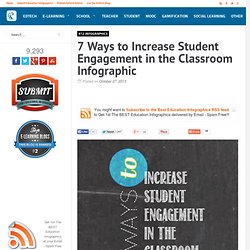
Because involved students learn more efficiently and are more successful at remembering what they learned. Disruption! 6 Types of Blended Learning. From Tweet to Blog Post to Peer-Reviewed Article: How to be a Scholar Now. Digital media is changing how scholars interact, collaborate, write and publish.
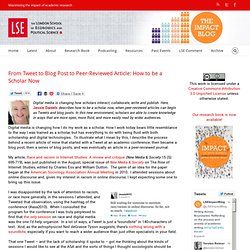
Here, Jessie Daniels describes how to be a scholar now, when peer-reviewed articles can begin as Tweets and blog posts. In this new environment, scholars are able to create knowledge in ways that are more open, more fluid, and more easily read by wider audiences. ICTs & Higher Education Trends Opportunities Concerns 2012. Learning pathways. What the flip? How Do You Measure Learning? Teaching Strategies Getty It’s not a new question, but it’s certainly a divisive one — how to best measure student learning.
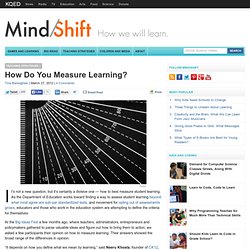
As the Department of Education works toward finding a way to assess student learning beyond what most agree are sub-par standardized tests, and movement for opting out of assessments grows, educators and those who work in the education system are attempting to define the criteria for themselves. At the Big Ideas Fest a few months ago, where teachers, administrators, entrepreneurs and policymakers gathered to parse valuable ideas and figure out how to bring them to action, we asked a few participants their opinion on how to measure learning. Their answers showed the broad range of the differences in opinion. “It depends on how you define what we mean by learning,” said Neeru Khosla, founder of CK12, a nonprofit open education source for free Web-based content in the form of digital “Flexbooks.”
“There are so many ways to measure student growth,” she said. Related. Learning Styles – a cautionary tale of sloth and complacency « ethinking. The learning styles debate crossed my radar on Twitter this week.
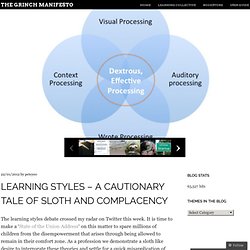
It is time to make a ‘State of the Union Address‘ on this matter to spare millions of children from the disempowerment that arises through being allowed to remain in their comfort zone. As a profession we demonstrate a sloth like desire to interrogate these theories and settle for a quick misapplication of vocabulary we already possess: Visual – pictures Auditory – Listening Read Write – Text. Content as curriculum? 7 Stories From Educators About Teaching In The Flipped Classroom. Informed articles and commentary on this powerful and often misunderstood concept.
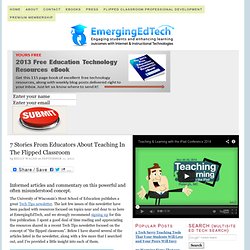
The University of Wisconsin’s Stout School of Education publishes a great Tech Tips newsletter. The last few issues of this newsletter have been packed with resources focused on topics near and dear to us here at EmergingEdTech, and we strongly recommend signing up for this free publication. I spent a good deal of time reading and appreciating the resources shared in a recent Tech Tips newsletter focused on the concept of “the flipped classroom”. Below I have shared several of the articles listed in the newsletter, along with a few more that I searched out, and I’ve provided a little insight into each of them. Why Is the Research on Learning Styles Still Being Dismissed by Some Learning Leaders and Practitioners? I have been battling the notion of "designing instruction for learning styles" in my own quixotic fashion for a couple of decades now.

In my attempt to be a good steward of my clients' shareholders' equity I wished to help them avoid faddish instructional design practices that have been disproven by empirical research. I first learned back in the 1980s at NSPI (now ISPI) conferences that while self-reported learning style preferences do exist, that designing instruction to accommodate them has no basis. When I posted yet again on this topic on my blog a couple of months ago and then sent a Tweet out about it—Jane Bozarth, EIC of this magazine, invited me to publish an article. I accepted and decided to reach out to the usual suspects, those in my professional crowd who know the research, for their inputs. As I am but a practitioner attempting to follow what I have learned over the years about the research, I am not steeped in that research and able to cite it, they can.
From Richard E. Teaching Critical Thinking: Are We Clear? November 30, 2011 By: Maryellen Weimer, PhD in Teaching Professor Blog I’ve been thinking about critical thinking.

I just finished reading Stephen Brookfield’s new book on the topic, Teaching for Critical Thinking. (Side note: Stephen is a prolific author, writing on a variety of teaching-learning topics and his work has generated a number of classics including The Skillful Teacher, Discussion as a Way of Teaching, co-authored with Stephen Preskill, and Becoming a Critically Reflective Teacher. If you don’t know his work, by all means add it to your reading list). Critical thinking seems like such an abstract, even elusive, concept to me. Education in 2025.mov
How technology can be used to improve education – a matter of opinion « Online Education News. Conole nlc. Diana Laufenberg: How to learn? From mistakes. Ken Robinson says schools kill creativity. Sir Ken Robinson: Bring on the learning revolution!
How the Sheep are Led to Slaughter Fiat Money Web. The Machine is Us/ing Us (Final Version) LLLandWeb20preprint. Social constructivism. Social constructivism is a sociological theory of knowledge that applies the general philosophical constructivism into social settings, wherein groups construct knowledge for one another, collaboratively creating a small culture of shared artifacts with shared meanings.
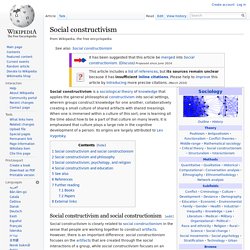
Connectivism: A Theory of Personal Learning. A Vision of Students Today.